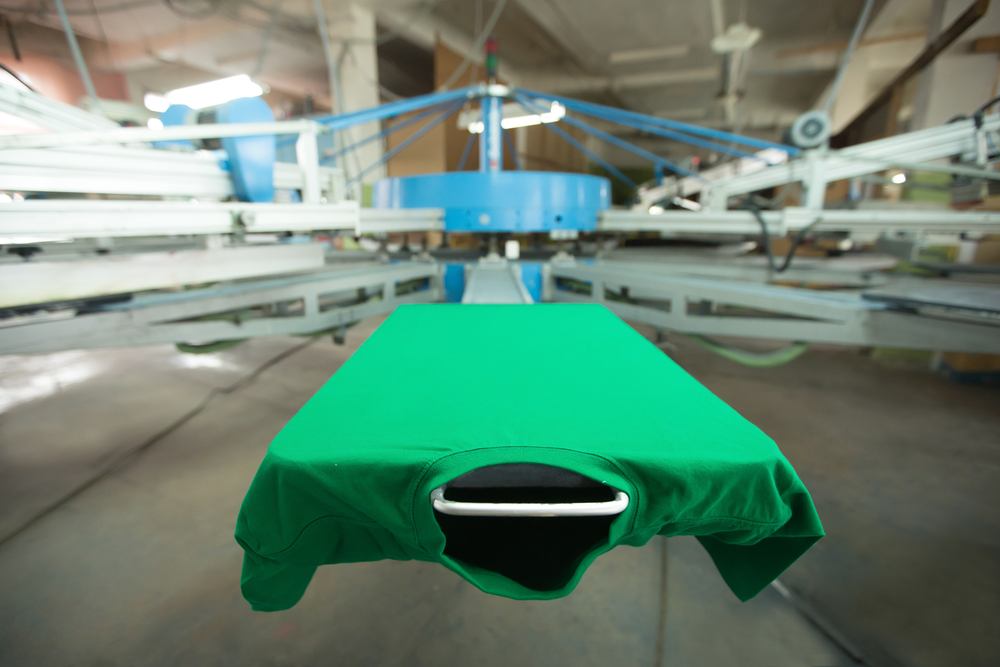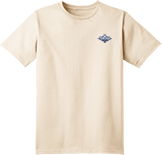The Comprehensive Guide to Understanding the Screen Printing Process

Posted by Naji Jr. on to Technical Guides
The Comprehensive Guide to Understanding the Screen Printing Process
Introduction
Whether you're a budding artist looking to get your designs onto clothing or an entrepreneur exploring custom merchandise for your brand, screen printing is a versatile solution that has stood the test of time. Delve into this comprehensive guide to understand the entire screen printing process from start to finish.
1. Dive into Screen Printing: An Art of Precision and Creativity**
Unveiling the Magic behind Screen Printing
Screen printing, sometimes referred to as silk screening, stands as a testament to the blend of technology and craftsmanship in the realm of print design. This age-old technique involves transferring a graphic design onto a substrate using intricately woven mesh screens, vibrant inks, and the simple yet effective squeegee.
Tracing its origins back to ancient China, screen printing has evolved, with modern advancements heightening its precision and efficiency. Its enduring popularity arises from its ability to produce vibrant, sharp, and long-lasting prints. From the casual tees we wear that carry bold statements or the artistic prints on ceramics, to the concert posters that grace our walls - screen printing is everywhere, bearing a legacy of both tradition and innovation.
Search engines and curious minds often ask, "Why choose screen printing over other methods?" The answer lies in its versatility. Regardless of whether the canvas is a soft fabric, a ceramic mug, or premium quality paper, screen printing ensures high-definition and durable prints that can withstand the test of time.
2. Dissecting the Screen Printing Process: Key Components and Their Roles
Understanding the Building Blocks of Screen Printing
- Screens: The unsung heroes of the screen printing process. These are constructed from finely woven mesh, typically polyester, stretched tautly over a frame. The mesh density or count varies, with lower counts used for bolder designs and higher counts for more detailed graphics. It's this screen that dictates the precision and clarity of the print, acting as a stencil for the ink to pass through.
- Inks: More than just a color medium, the inks in screen printing define the vibrancy and longevity of a design. Screen printing inks are specially formulated to bond with the substrate, resisting wear and tear. Whether you opt for water-based inks, known for their eco-friendliness and soft texture, or plastisol inks, renowned for their durability and bold color output, the choice impacts the final look and feel of the printed design.
- Squeegee: At first glance, it might seem like a simple tool, but the squeegee is pivotal in the screen printing process. Made of rubber or polyurethane, it's used to smoothly and evenly push the ink through the mesh screen onto the substrate. The angle, pressure, and speed at which the squeegee is used can influence the ink's distribution, affecting the print's clarity and sharpness.
- Substrate: The canvas of screen printing, substrates can be as varied as one's imagination. Whether it's the classic cotton T-shirt, a collector's edition poster, ceramic tiles, or even skateboards, the substrate not only dictates the type of ink used but also the preparation required before printing. It's essential to choose substrates that complement both the design and the ink for a flawless print outcome.
3. Navigating the Screen Printing Process: A Detailed Walkthrough
a. Crafting the Perfect Design: Every great print begins with a captivating design. With today's digital tools like Adobe Illustrator or Photoshop, artists can achieve unparalleled precision. Whether you're drawing a bespoke artwork or a brand logo, ensuring a high-resolution, vector format will guarantee clarity and sharpness in the final print. This step sets the tone, so invest time in getting your design just right. Remember, a quality design translates to a quality print.
b. Preparing the Screen for Magic: This is where the intricacies of the process begin to unfold. The chosen screen, determined by the appropriate mesh count for your design, is coated evenly with a photosensitive emulsion. This unique emulsion is sensitive to light and undergoes a transformation when exposed, hardening and becoming impermeable to ink.
c. Illuminate to Differentiate: Your design, printed onto a transparent film, is now placed against the emulsion-coated screen. When exposed to a strong light source, a beautiful science unfolds: areas of the screen covered by the design block out the light and remain soft, whereas the rest of the emulsion hardens.
d. Rinsing Reveals the Blueprint: After exposure, the screen is gently rinsed with water. The magic becomes evident as the soft emulsion areas (shielded by the design) wash away, revealing a perfect stencil of your artwork. This process ensures accuracy, preparing the screen for the inking phase.
e. The Art of Inking: With the stencil-ready screen positioned over your chosen substrate, the transformation is almost complete. Specific screen printing inks, chosen based on the substrate and desired outcome, are poured onto the screen. The trusty squeegee comes into play, evenly pressing and spreading the ink through the screen mesh and onto the substrate, manifesting the design.
f. Finalizing with a Cure: To ensure your design isn't just a fleeting beauty, the inked substrate is cured, typically using heat. This process solidifies the ink, making it resistant to wear, washing, and fading. This step is vital; without proper curing, even the most exquisite design can deteriorate quickly.
4. Delving into the Advantages of Screen Printing
- Unparalleled Durability: One of the standout features of screen printing is the longevity it offers. Through the precise application of ink and the curing process, designs resist wear, tear, and fading, making them last for years, even with regular use.
- Stunning Vibrancy: If your design boasts bright, vivid colors, screen printing is your best bet. Unlike some other printing methods, screen printing saturates the substrate with ink, resulting in exceptionally vibrant outputs that capture attention.
- Limitless Versatility: From soft fabrics to rigid ceramics, screen printing doesn't discriminate. Its adaptability allows for printing on a myriad of materials, opening doors for creatives and businesses to diversify their product range.
- Economical for Larger Runs: While the initial setup of screen printing may require effort, it becomes incredibly cost-effective for bulk orders. The per-unit cost drops significantly, making it a favored choice for businesses seeking large quantities.
5. Screen Printing vs. Digital Printing: Choosing the Right Print Technique for Your Project**
In the vibrant world of print design, the debate between screen printing and digital printing is a compelling one. Each brings its unique advantages, catering to different needs and projects.
Screen Printing: A method deeply rooted in tradition, screen printing has been the go-to for bulk orders and designs that demand vibrancy. As earlier explained, screen printing utilizes screens as stencils to layer inks onto a substrate. It's revered for:
- High Color Saturation: It offers unmatched vibrancy, making designs pop.
- Cost-Efficiency for Bulk Orders: The per-unit cost reduces significantly in larger quantities.
- Durability: With the right curing, these prints last longer, making them ideal for merchandise like t-shirts.
Digital Printing (Direct-to-Garment): A relatively newer entrant, digital printing is akin to the process of a typical inkjet printer but on fabrics or substrates. It stands out for:
- Detailed Designs: Ideal for designs with intricate details and gradients.
- Flexibility in Color: Multiple colors can be used without setup changes.
- Short Runs: Since there's no initial setup like screens, it's more cost-effective for smaller quantities.
- Rapid Turnaround: Faster production times for on-demand requests.
When deciding between the two, consider your design's intricacies, the order quantity, and the desired finish. For instance, if you're a budding designer wanting to try out multiple designs in limited quantities, digital printing might be your ally. Conversely, for businesses looking to produce branded merchandise in bulk, screen printing could be the economical and vivid choice.
6. Mastering the Art: Essential Tips for Successful Screen Printing
Embarking on the screen printing journey can be both exciting and challenging. With the potential to transform simple substrates into pieces of art or brand statements, here are some golden tips to ensure success:
- Prioritize Design Quality: In the realm of screen printing, your print will only be as good as your design. High-resolution, vector-based designs are paramount for crisp, clear results. Using tools like Adobe Illustrator can help achieve this precision.
- Choose Wisely: Every substrate interacts differently with inks. From fabrics like cotton and polyester to materials like wood or metal, understanding their compatibility with different inks ensures longevity and vibrancy.
- Maintenance is Key: Over time, screens can accumulate residues that can mar the quality of your prints. Regularly cleaning them ensures consistency. Additionally, store screens in cool, dry places to enhance their lifespan.
- Patience and Practice: Like any craft, screen printing comes with its learning curve. Mistakes are stepping stones to mastery. Whether it's understanding the right squeegee pressure or perfecting the ink consistency, practice and patience are your best companions.
Utilizing SEO for Enhanced Visibility in Screen Printing Content
For businesses and bloggers in screen printing, ensuring SEO-optimized content can make all the difference. Incorporating popular and relevant keywords, like "digital vs. screen printing," "best substrates for screen printing," or "how to maintain screen printing equipment," can enhance the content's discoverability online. Seamlessly integrate these terms to engage readers while boosting search engine rankings.
Conclusion
Screen printing is a blend of art and science. With its roots tracing back over a thousand years, it has evolved with technology while maintaining its core principles. For brands and artists, it offers an avenue to create memorable, lasting designs. Dive in, experiment, and let your creativity flow!
Categories
Recent Posts
- The Best Custom Polos for Workwear and Events
- The Most Popular Custom Hats for Every Occasion
- Why Choose a Mesh Back Hat?
- Exploring Backstrap Options: The Benefits and Drawbacks of Popular Hat Closures
- The Perfect Pair: Branded Bills Hats for Embroidery
- Trendy Camo Hats for the Outdoors: Customize the Richardson 111P with LogoUp
- The Ultimate Guide to Customizing the Richardson 320 Washed Chino Hat with Embroidery
- Embroidery on the Otto Cap 39-165: High-Performance Customization for Every Occasion
- LogoUp Holiday Gifts: Embroidered and DTF-Decorated Richardson 112, 112PFP, and 112PM
- Gifting LogoUp Custom Campfire Mugs: Thoughtful, Versatile, and Personalized















































































Add Comment